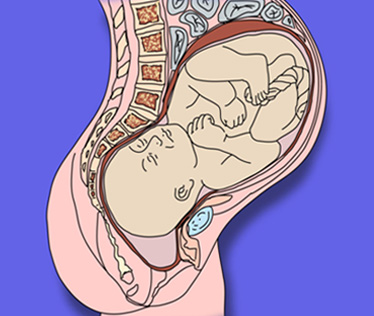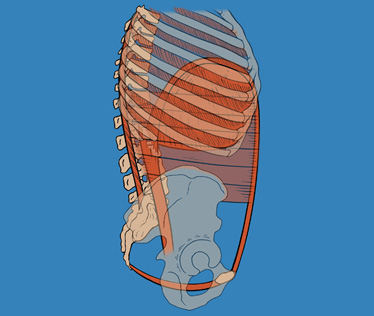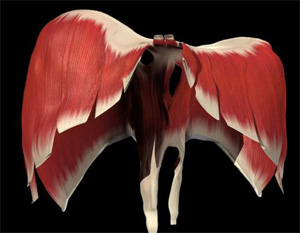Exercise during pregnancy
It is important to continue to exercise daily during your pregnancy. If you are not a regular exerciser, then my advice is to get going because you have a marathon event coming up! Walk, swim, find a prenatal Yoga or exercise class and be sure to do something active every day.
As you exercise, here are a few things to pay attention to as your body changes both throughout your pregnancy and in the early weeks after you deliver.
- Pay attention to when your body tells you to stop, then stop. The joints of your low back and pelvis should NOT CLICK when you exercise (or move for that matter!).
- Do not overheat.
- Drink plenty of water.
- Stop doing sit-ups or double leg lifts while lying on your back.
Why it is important to stop doing sit-ups during pregnancy?
Your abdomen will become very stretched as your pregnancy progresses and your intra-abdominal pressure will rise. This places considerable stress on the midline connection of the abdominal wall (the linea alba) and increases the risk of developing a diastasis rectus abdominis or DRA.
Watch this 38-week pregnant woman do a small curl-up and you’ll see why sit-ups are NOT recommended as an abdominal exercise during the 3rd trimester of pregnancy. Midline abdominal doming (the bulge in the center of the abdomen) usually means that your deep stabilizing muscle (transversus abdominis) is not able to manage this load at this time, or during this task. While your abdomen needs to be effective, and strong, both during your pregnancy and after, this is not the way to begin to train it.
Pregnancy & delivery present a huge challenge for your abdominal wall and pelvic floor
The abdomen and pelvic floor (two parts of the ‘core’) are significantly challenged during pregnancy and delivery and a bit of education and a few exercises can help to ensure an optimal postpartum recovery.



A ‘fit’ core and proper support can make the final months of pregnancy and the early postpartum period more comfortable. Wearing the Baby Belly Pelvic Support™ can reduce your pain, allow you to train more and therefore be fit for delivery and beyond.
What exercises should you do to protect your expanding and challenged ‘core’ to be fit to deliver?
1. Learn to use your deepest abdominal (the transversus abdominis) it is your internal maternity belt.

An efficient abdominal wall not only helps to support your growing belly but also helps you deliver your baby. During pregnancy, the best position to train your abdomen is in the position of delivery – a squat. Bend your hips and knees, tilt your trunk slightly forward and let your belly go, relax. Cup your low belly just above your pubic bone with one hand and gently try to lift the lowest part of your abdomen off your pubic bone and away from your hand.
See the exercise sheet ‘Transversus Abdominis Training‘ for more ideas and cues to activate this muscle.
Keep your chest relaxed and breathe while you maintain several 3-5 second contractions of this deep abdominal. Do this often during the day; transversus abdominis is your internal Baby Belly Pelvic Support!
2. Learn to use your breath (the diaphragm) to help you push and to control pain.

The diaphragm forms the roof of your deep core and is both a breathing muscle and a postural stabilizer. Understanding how to use your breath will help you during your contractions (for pain relief) and also help you push your baby out. In your small squat position take a big breath in and let your belly relax and grow bigger. Then as you breathe out relax your chest and lift your lower belly (connect to transversus abdominis).
Hold your belly lifted and then use your diaphragm to GENTLY push towards your pelvic floor. See if you can feel the push in your vagina and not your rectum or urethra. Find the door of your pelvic floor using your diaphragm and transversus abdominis to push.
3. Learn to release/relax your pelvic floor
Your pelvic floor muscles are responsible for many things including stabilizing your pelvis and maintaining urinary and stool continence. Most women have heard of Kegel exercises and are advised to elevate and contract their pelvic floor muscles often. However, the pelvic floor is your baby’s door and being able to relax these muscles is very important for a vaginal delivery as well as for proper pelvic organ support, continence and stabilization. Research has shown that many women with incontinence, pelvic pain and/or organ prolapse hold their pelvic floors too contracted. Therefore, knowing how to contract AND RELAX your pelvic floor is essential for this time of your life and beyond.
Sit on a soft inflatable ball (i.e. Soft Gym Overball) and let the ball sink into the muscles of your pelvic floor. Then, imagine your pelvic floor as a clock with your tailbone being 6 o’clock, your pubic bone 12 o’clock and the left and right sides 9 and 3 o’clock. Gently draw 12 o’clock towards your vagina, then 6 o’clock to the same area and then repeat for 9 and 3 o’clock. Now that you have gathered together the circumference of your pelvic floor see if you can gently lift your vagina up off the ball slightly. Equally important, see if you can relax the circumference of the pelvic floor and let the ball sink into your pelvic floor muscles. When done properly you will also feel your lower belly lift just above your pubic bone when you contract the pelvic floor muscles – that is transversus abdominis contracting in synergy with your pelvic floor muscles, they should work together. Learn to close and open the door of your pelvic floor and be sure to also practice in your small squat. This is a key skill for life.


4. Healthy squats forever!

Hopefully you will have an uneventful delivery and can have your baby upright and thus let gravity help you. This means you need strong legs and hips to support a sustained squat position.
For many years after your delivery you will be doing lots of lifting. Time to strengthen your butt and legs!
Sit with your buttocks against a wall but not your upper back (like sitting in a chair). Make sure your knees are directly over your feet, connect to the deep core muscles, let your sitz bones widen, your hips fold and then sink into your legs (squat) several times a day – squats are essential exercises for life.
After delivery – the first 6 weeks
After your baby is born, your abdominal wall and pelvic floor will immediately feel very different; in fact they may feel absent. Don’t do anything vigorous for the first 6 weeks; just let your body heal. This is true whether you delivered vaginally or by C-Section. You can start engaging your pelvic floor and transversus abdominis periodically during this time and if you’ve been practicing these exercises throughout your pregnancy you will know when these muscles are working again.
This is the time to focus on your posture in standing, sitting, lifting, nursing etc. Watch for the tendency to slump or sway your pelvis forward in standing. The habits developed during this critical time can last a lifetime – watch your posture and heal. This is also the time to wear your Baby Belly Pelvic Support™!
Returning to exercise after delivery

Physiotherapists are passionate about helping Moms get fit and functional after pregnancy and a flyer ‘Your Body after Baby’ has been developed by physiotherapists at both Diane Lee & Associates (led by Rachael Corbett) and BC Women’s Hospital to know what to check for before you return to intensive exercise.
For the future health of your back, pelvis, bladder and uterus it is essential that you have a postpartum screen and this flyer will take you through a few simple tests to see if you are ready for more intensive exercise.
Download this postpartum brochure and be sure to get your abdominal wall and pelvic floor screened by a qualified physiotherapist before you return to exercise so you can be fit to function, fit to train and fit to live an active healthy life.
Abdominal wall training after pregnancy & delivery
Once you can co-activate transversus abdominis and your pelvic floor and hold this contraction for 3-5 seconds, you are ready to start strengthening and integrating these core muscles into higher load tasks. It is important to ‘train the brain’ pattern before you start strengthening. For more information on this topic see the article ‘Core Training vs Core Strengthening. What is the Difference and Why Does it Matter?
Specific exercises and progressions for your transversus abdominis can be downloaded here
Specific exercises and progressions for your pelvic floor can be downloaded here
If you’ve been told by your physiotherapist that your core problem is in the deep fibres of multifidus (a posterior stabilizer), specific exercises for this muscle can be downloaded here.
Some things to watch for as you start to train again
This woman is only 8 days postpartum – watch the bulging of her low abdomen when she lifts either leg or does a short head and neck curl-up. The midline of her abdomen is not ready to handle high loads yet! The Baby Belly Pelvic Support™ would certainly support her low abdomen and help her get
This woman is seven months postpartum – watch the bulging of her abdomen when she lifts both legs. The midline of her abdomen is structurally fine and she is ready to train, however her brain has totally forgotten how to use transversus abdominis! Too many of these leg lifts will certainly lead to more problems than she has now. She definitely needs brain training before strengthening – more on this to follow.
This woman is also well past the healing stage of 8 weeks postpartum – note the bulging or doming of her abdomen and the impact of this strategy on the midline connective tissue called the linea alba (seen via ultrasound imaging). When she activates the transversus abdominis, the bulging of her abdominal wall is immediately reduced and lovely tension in the lineaalbais both palpable and seen via ultrasound imaging.
Once the brain knows how to use the deep core muscles (transversus abdominis, pelvic floor and deep multifidus) in a co-operative way, the next step is to ensure that the superficial oblique abdominals (the external and internal oblique) are working as they should so as not to excessively pull the linea alba apart.
Watch the video below to see the cues we use to train the brain and balance the activation of the oblique abdominals so as to control the forces through the linea alba. This will help your linea alba regain its pre-pregnancy tensile strength.
A common postpartum strategy in standing is to overly grip the lower chest with the external oblique muscles. This habit creates ‘divots’ in the upper abdominal wall and actually increases bulging or protrusion of the lower abdomen as the intra-abdominal pressure increases. This is called a pressure-belly.
Watch this postpartum women relax her external oblique muscles and then re-engage her abdominals from the inside out (transversus abdominis first) and note the difference in the appearance of her abdominal wall.
Once the deep and superficial abdominal core muscles are working synergistically, it’s time to get back to fitness! The figures below are of the same woman. Left – 32 weeks pregnant, middle – 2 days postpartum and right – 6 weeks postpartum. The final video is her 9 months postpartum back to her favourite fitness routine – kick-boxing!


